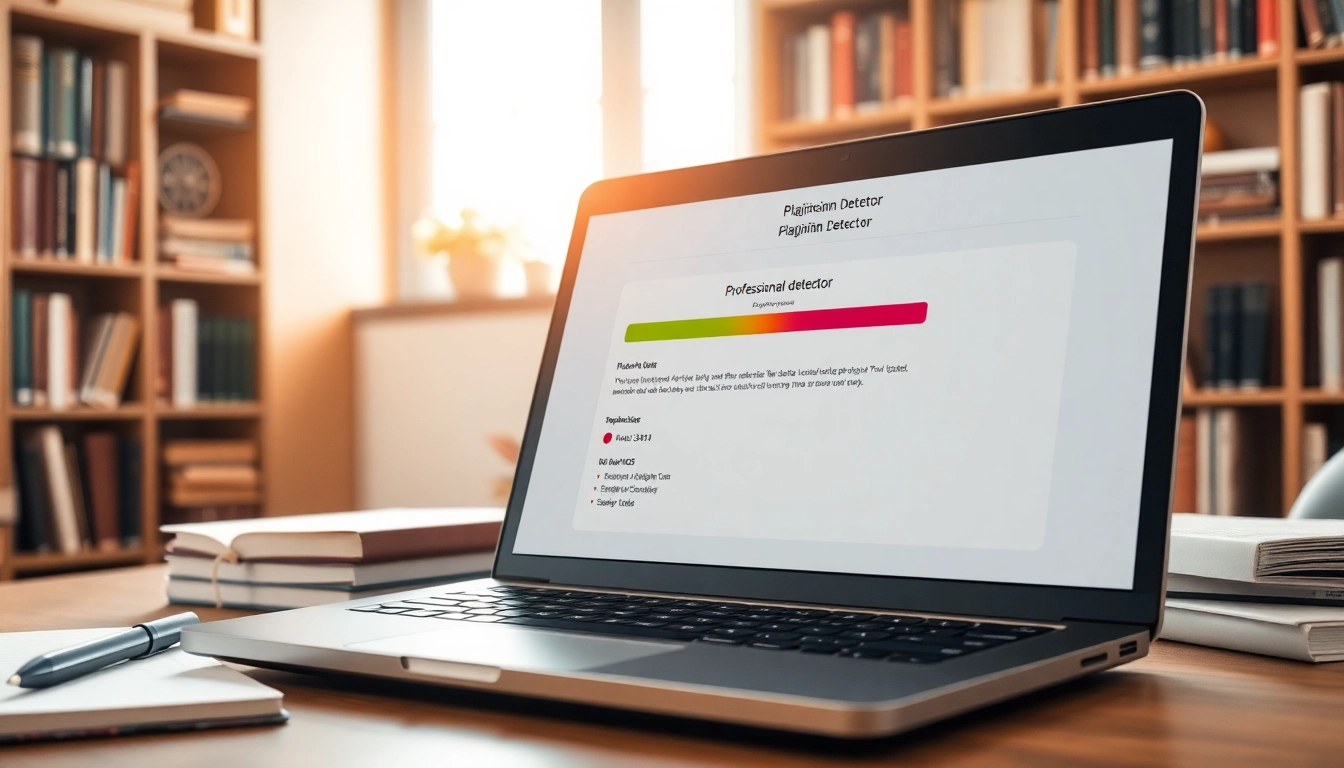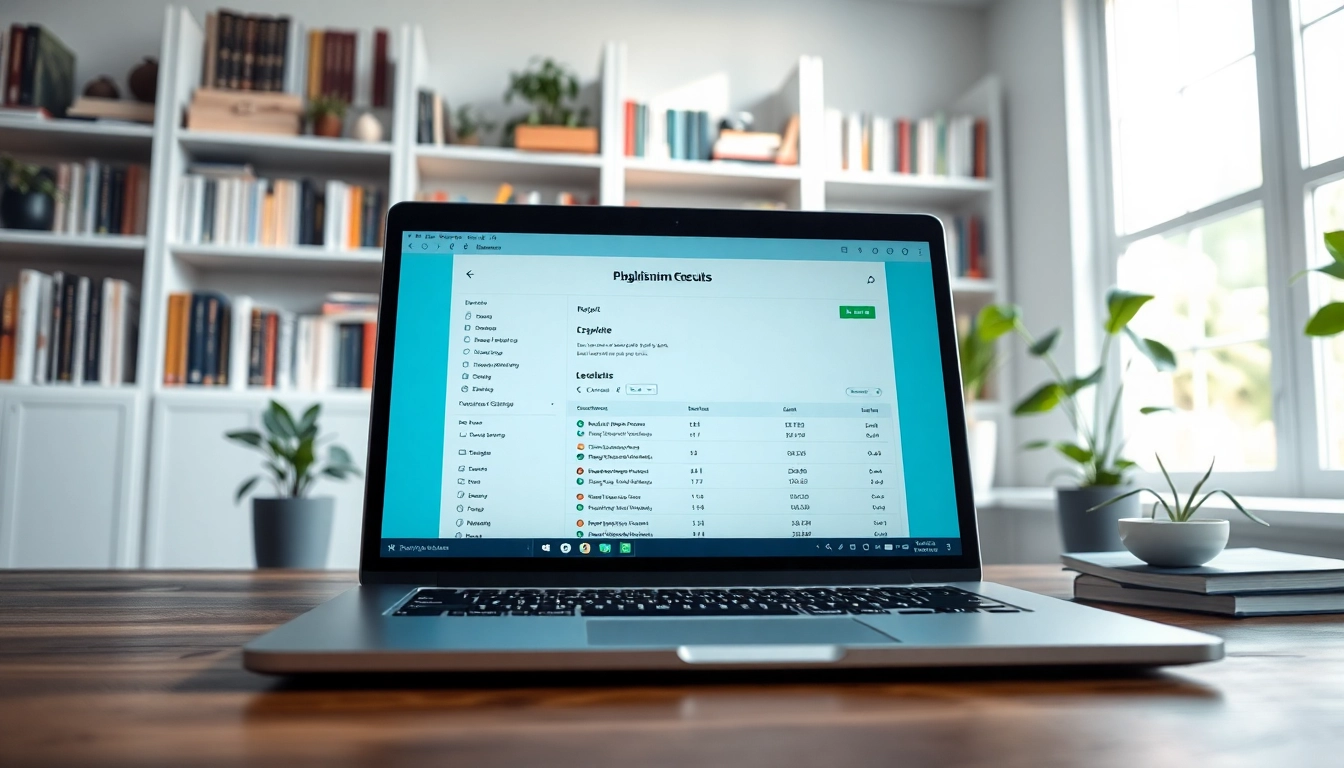Understanding Plagiarism Detectors
What is a Plagiarism Detector?
A plagiarism detector is a specialized tool designed to identify instances of plagiarism in text. This software checks documents against a vast database of existing literature, online content, and publications to ascertain whether the content is original or copied from other sources. Tools like these are essential for academic institutions, publishers, and individuals seeking to ensure integrity and originality in their writing. The proliferation of digital content emphasizes the need for a reliable plagiarism detector to maintain the standards of originality in various fields.
How Plagiarism Detectors Work
Plagiarism detectors utilize algorithms and database comparisons to analyze text. They typically follow these steps:
- Text Input: Users submit the text they want to check.
- Text Processing: The software breaks the text into smaller parts, such as sentences or phrases, to prepare it for comparison.
- Database Comparison: The processed text is then compared against a database that includes academic publications, web pages, and other text sources.
- Report Generation: Once the comparison is complete, the software generates a report highlighting matched sources, the percentage of plagiarized content, and suggestions for paraphrasing.
This method enables users to understand the extent of originality in their content and make necessary adjustments.
Importance of Using a Plagiarism Detector
In today’s digital landscape, the authenticity of content is paramount. Using a plagiarism detector carries several advantages:
- Academic Integrity: Students and educators can uphold ethical writing standards by ensuring the originality of submitted work.
- Professional Reputation: Authors, bloggers, and content creators maintain their credibility by providing unique and original work.
- Legal Protection: Detecting plagiarism helps in avoiding potential copyright infringements that can lead to legal consequences.
Ultimately, plagiarism detectors serve as a safeguard for originality, critical in maintaining the integrity of educational and professional institutions.
Top Features of Effective Plagiarism Detectors
Accuracy and Speed
One of the most critical features of any plagiarism detector is its accuracy. An effective tool should minimize false positives (incorrectly identifying original content as plagiarized) and false negatives (failing to detect actual plagiarism). Speed is equally important; users expect results promptly, especially in academic and professional environments where deadlines are stringent. Tools that combine high accuracy with rapid scanning capabilities stand out in a competitive market.
User-Friendly Interfaces
A user-friendly interface enhances the overall experience of using a plagiarism detector. Features such as a simple, intuitive design, easily navigable menus, and clear instructions make it accessible for all users, not just tech-savvy individuals. Tutorials or guided options can also help first-time users understand how to utilize the tool effectively.
Integration with Writing Software
Seamless integration with popular writing software—such as Google Docs, Microsoft Word, and other content management systems—enables users to check their work for originality without needing to switch platforms. This feature not only saves time but also encourages users to make plagiarism checking a standard part of the writing process.
Choosing the Right Plagiarism Detector
Comparing Free and Paid Options
When selecting a plagiarism detector, it’s essential to weigh the pros and cons of free vs. paid options. Free tools might provide basic detection services but often have limitations in functionality, database size, and features like advanced reporting or real-time detection. Paid options typically offer more comprehensive features, including access to extensive resources and better customer support. Evaluating which option aligns with your needs (e.g., frequency of use, depth of analysis required) is crucial in making an informed decision.
Evaluating Vendor Reputation
Choosing a reputable vendor is critical for ensuring the effectiveness of a plagiarism detector. Look for companies with a history of reliability and positive feedback from users. Research reviews on independent sites and forums, and look for testimonials that attest to the tool’s performance. Trustworthy vendors are transparent about their methods, database coverage, and privacy policies, which fosters trust among users that their work is secure and confidential.
User Reviews and Case Studies
User reviews and case studies provide insights into the practical application and effectiveness of plagiarism detectors. Analyzing user feedback can illustrate common strengths or weaknesses of specific tools. Additionally, case studies showing how institutions or businesses have successfully implemented these tools can highlight the tangible benefits and outcomes, aiding prospective users in selecting the right software.
Implementing a Plagiarism Detector in Academic Settings
Best Practices for Educators
For educators, integrating a plagiarism detector into the curriculum involves establishing a routine practice of originality checks. Key best practices include:
- Institutional Policy Development: Create clear guidelines regarding the consequences of academic dishonesty and the role of plagiarism detection in maintaining integrity.
- Tool Familiarization: Ensure both educators and students become familiar with the chosen plagiarism detection tool, highlighting functionalities that can assist in both learning and teaching.
- Encouragement of Ethical Writing: Promote the importance of originality; this can include lessons on paraphrasing, citation styles, and proper research practices.
Guidelines for Students
Students can benefit significantly from using plagiarism detectors as part of their writing process. Guidelines include:
- Proactive Checking: Encourage students to check their work multiple times during the writing process, rather than just before submission. This helps identify potential issues early.
- Understanding Reports: Teach students to interpret plagiarism reports properly, focusing on how to address flagged content through paraphrasing and citation.
- Peer Collaboration: Promote peer reviews wherein students can help each other by citing plagiarism detector results and discussing improvements collaboratively.
Institutional Policies on Plagiarism
Establishing institutional policies on plagiarism is essential to foster a culture of integrity. Policies should cover:
- Definition of Plagiarism: Clearly outline what constitutes plagiarism, including self-plagiarism and direct copying.
- Detection Protocol: Define how and when plagiarism checks will be conducted, promoting transparency in the process.
- Consequences: State the repercussions of plagiarism, emphasizing that penalties will be enforced consistently to deter dishonest practices.
Future Trends in Plagiarism Detection Technology
AI and Machine Learning Innovations
The future of plagiarism detection is being shaped by advancements in artificial intelligence (AI) and machine learning. These technologies are improving the ability of plagiarism detectors to not only identify copied content but also discern and evaluate nuanced similarities in writing styles. As algorithms evolve, detectors may begin to offer suggestions for originality improvements, making them not just tools for detection, but also for enhancing writing quality.
Cross-Language Detection Capabilities
The global nature of academia and content creation necessitates tools that can operate across different languages. The integration of multilingual databases and detection capabilities means that plagiarism detectors can analyze texts in various languages, enhancing their utility for diverse users. As technology evolves, we can expect enhanced support for less common languages and dialects.
Integration with Content Management Systems
Future plagiarism detection tools are increasingly likely to integrate with prominent content management systems (CMS) and educational platforms. This deeper integration will streamline the writing and editing processes, allowing users to check originality in real time without disrupting their workflow. Such features may include automatic checks upon submission, providing instant feedback and fostering a culture of originality across platforms.



